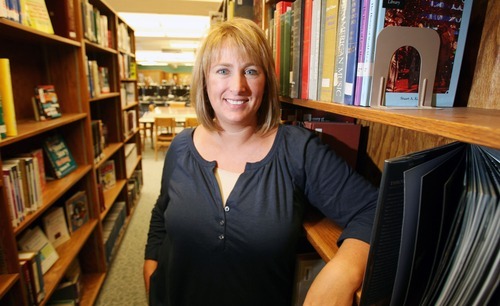This is an archived article that was published on sltrib.com in 2011, and information in the article may be outdated. It is provided only for personal research purposes and may not be reprinted.
Sitting in the Library of Congress last month, Rachel Murphy was a student all over again.
She was flipping through pictures of U.S. military ski brigade units training at Alta Ski Resort in 1942, reading about Utah's connection to World War II and experiencing firsthand the connection she hopes to bring to Kearns High students.
"History happens everywhere, it happens in our backyard," said Murphy, the library media specialist at Kearns. "World War II … you think about happening all over Europe, but it impacted us here as well. There are connections students can make to Utah and World War II."
Murphy spent five days in Washington, D.C., as part of the Library of Congress Teaching With Primary Sources Summer Teacher Institute. She brought back a binder more than 3 inches think, filled with resources to pass on to teachers and students in an effort to promote the supplemental teaching materials.
She described primary-source teaching as "using documents from the time in history being studied," essentially using photos, maps, manuscripts and audio and video recordings to help aid students in the learning process.
Primary-source teaching seems to fit hand-in-hand with subjects such as history and social studies, but Murphy said it has a purpose in just about any course at school.
"If we're reading a novel with historical references — and a lot of what literature classes read are historical fiction or classic novels — they can go back and pull documents from that time frame in history," she said. "Sciences — if you're studying inventors, you can look at their original drawings."
The Library of Congress began digitally archiving its collection about a decade ago and now has millions of items available to the public at loc.gov. Teachers can download audio files of people talking about the Vietnam War, or maps from the 1800s, and use them as teaching tools.
"It shouldn't take teachers too much effort to find something that relates to their curriculum because [the Library of Congress] have done so much work organizing it," said Murphy, who was one of 20 educators in the program. The Library of Congress holds seven summer sessions a year, open to educators of grades K-12.
Kearns teacher Steve Miller encouraged Murphy to apply for the Library of Congress program because he is looking for a primary-source application Kearns students can download onto their school-issued iPods.
He estimated he uses primary sources two or three times a week and uses old political cartoons as much as anything available. Miller said using primary sources really helps students connect with the subjects they study.
The Library of Congress "hired people to interview people impacted by the Great Depression, and I use [an audio recording] as an essay exam," said Miller, a social-studies teacher who has been at Kearns for 24 years. "They have to respond to the person's comments as if they were the government trying to deal with the person's issue. It opens their hearts, is what it does. And they begin to see history comes alive."
Primary-source teaching
R Kearns High Library Media Specialist Rachel Murphy attended the Library of Congress Teaching With Primary Sources Summer Teaching Institute in August.
She champions the use of primary sources — "documents from the time in history being studied" — and helps assist teachers in finding sources to supplement their textbooks.
The Library of Congress has millions of photos, maps, manuscripts and audio and video recordings available free to the public at loc.gov.





